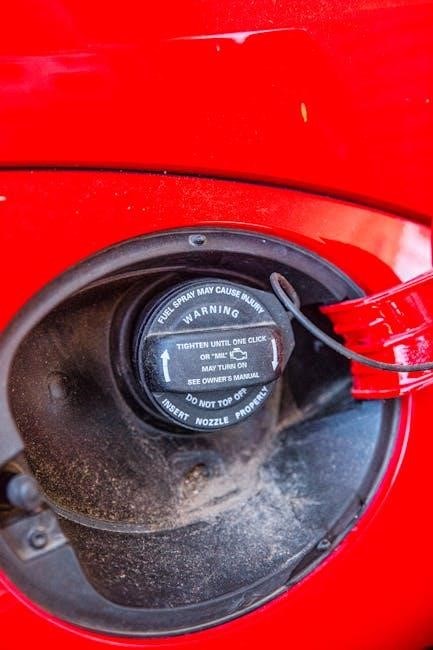Welcome to the Craftsman Air Compressor Owner’s Manual, your comprehensive guide to safe and efficient operation. This manual covers essential safety, assembly, and maintenance procedures to ensure optimal performance and longevity of your equipment.
1.1 Overview of the Manual
This manual provides a detailed guide for the safe and efficient operation of your Craftsman Air Compressor. It includes essential safety precautions, assembly instructions, and maintenance tips to ensure optimal performance. The manual covers topics such as proper installation, daily checks, and troubleshooting common issues. By following the guidelines outlined, you can maximize the lifespan and efficiency of your air compressor while minimizing potential hazards. This comprehensive resource is designed to help you understand and utilize your equipment effectively, ensuring a safe and productive experience.
1.2 Importance of Reading the Manual
Reading the Craftsman Air Compressor Owner’s Manual is crucial for safe and efficient operation. It provides essential safety guidelines, assembly instructions, and maintenance tips to ensure optimal performance. Understanding the duty cycle, proper ventilation, and lubrication requirements prevents damage and extends the compressor’s lifespan. The manual also helps troubleshoot common issues and ensures compliance with warranty terms. By following the guidelines, users can avoid hazards, maintain efficiency, and enjoy reliable service from their air compressor. Take the time to read thoroughly to maximize safety and performance.
Safety Guidelines and Precautions
Always follow safety guidelines to prevent accidents. Wear protective gear, ensure proper ventilation, and avoid overloading. Adhere to the recommended 50% duty cycle for safe operation.
2.1 General Safety Instructions
Always wear protective eyewear and ensure proper ventilation when operating the air compressor. Keep loose clothing and long hair tied back to avoid entanglement. Never touch hot surfaces or electrical components. Ensure the compressor is placed on a stable, level surface. Avoid overloading the unit, as this can lead to malfunction. Follow the recommended duty cycle (50%) to prevent overheating. Keep flammable materials away from the compressor. Regularly inspect hoses and connections for damage or leaks. Adhere to all safety guidelines outlined in this manual to ensure safe and efficient operation.
2.2 Handling Compressed Air Safely
Always follow safety guidelines when handling compressed air to prevent accidents. Ensure the system operates within the recommended pressure ratings and duty cycle limits (50% duty cycle: 5 minutes of operation in any 10-minute period). Use approved hoses and fittings to avoid leaks or ruptures. Never exceed the compressor’s maximum pressure rating, as this can lead to system overload. Regularly inspect hoses and connections for wear or damage. Proper handling ensures safe and efficient operation of your Craftsman air compressor.
2.3 Proper Ventilation Requirements
Proper ventilation is crucial for safe and efficient operation of your Craftsman air compressor. Ensure the unit is placed in a well-ventilated area to prevent carbon monoxide buildup and reduce moisture accumulation. Avoid operating the compressor in confined or poorly ventilated spaces, as this can lead to hazardous conditions. If used indoors, consider installing ventilation systems to maintain air quality. Always follow ventilation guidelines to ensure optimal performance and longevity of your equipment.

Assembly and Installation
Proper assembly and installation are crucial for safe and efficient operation. Follow step-by-step instructions for unpacking, inventory, and mounting to ensure correct setup and functionality.
3.1 Unpacking and Inventory
Begin by carefully unpacking your Craftsman air compressor from its shipping box. Inspect the unit for any visible damage during transit. Next, verify the contents against the provided parts list in the manual to ensure all components are included. This step is crucial to avoid missing items that may delay assembly. Once unpacked, organize the parts and accessories in a clean, dry workspace. Before proceeding with assembly, double-check that all hardware and instructions are accounted for. This systematic approach ensures a smooth setup process. Proper inventory helps prevent delays and ensures all necessary parts are readily available.

3.2 Step-by-Step Assembly Instructions
Begin by unpacking and inventorying all components. Attach the wheels and handle to the compressor unit using the provided hardware. Next, install the air filter by threading it onto the intake port. Connect the pressure gauge and relief valve, ensuring they are securely tightened. Mount the control panel and connect the electrical wiring according to the diagram. Finally, attach the air hose to the outlet port and test for leaks. Refer to the diagrams for precise alignment and tightening specifications. Always maintain a 50% duty cycle for optimal performance.
3.3 Mounting and Leveling the Compressor
Proper mounting and leveling of your Craftsman air compressor are crucial for stable operation and longevity. Begin by placing the unit on a firm, flat surface. Use a spirit level to ensure the compressor is perfectly horizontal. Tighten all mounting bolts securely to prevent vibration. If installing on a uneven floor, use shims to achieve proper leveling. Ensure the area around the compressor is well-ventilated to prevent overheating. Follow the manufacturer’s guidelines for mounting hardware and spacing requirements to guarantee safe and efficient performance.
Operating the Air Compressor
Understand the control panel, start/stop procedures, and pressure adjustments. Maintain a 50% duty cycle to prevent overheating, ensuring efficient and safe operation of your Craftsman air compressor.
4.1 Understanding the Control Panel
The control panel is the central command center of your Craftsman air compressor, featuring essential gauges, switches, and regulators. It displays pressure levels, power settings, and operational status. Familiarize yourself with the pressure gauge, on/off switch, and regulator knob to adjust output pressure. The panel also includes indicators for duty cycle limits, ensuring proper operation within recommended guidelines. Always refer to the manual for detailed instructions on optimizing settings for your specific tasks.
4.2 Starting and Stopping the Compressor
To start the compressor, ensure the power source is connected and the pressure switch is in the “on” position. Allow the tank to fill before use. For stopping, switch off the power and let the unit cool. Always drain the tank after use to prevent moisture buildup. Adhere to the recommended 50% duty cycle to avoid overheating. Proper startup and shutdown procedures ensure efficient operation and extend the compressor’s lifespan. Follow these steps carefully to maintain performance and safety.
4.3 Adjusting Pressure Settings
To adjust the pressure settings on your Craftsman air compressor, locate the pressure regulator knob. Turn the knob clockwise to increase pressure or counterclockwise to decrease it. Ensure the pressure setting aligns with your tool’s requirements. The compressor’s duty cycle recommends not exceeding 5 minutes of continuous operation in any 10-minute period. Proper pressure adjustment ensures efficient performance and prevents overload. Always refer to the manual for specific pressure recommendations for your model. Correct settings optimize tool functionality and extend equipment lifespan. Adjust carefully to avoid over-pressurization, which can damage components or compromise safety.
Maintenance and Service
Regular maintenance ensures optimal performance. Perform daily checks, lubricate moving parts, and replace air filters as needed. Adhere to the recommended 50% duty cycle to prevent overheating and extend lifespan.
5.1 Daily Maintenance Checks
Regular daily inspections ensure your Craftsman air compressor operates efficiently and safely. Start by checking the oil level in the pump and topping it off as needed. Inspect hoses and connections for leaks or damage. Verify that all pressure gauges are functioning correctly and that the tank drain valve is not clogged. Clean or replace the air filter to maintain proper airflow. Finally, ensure the compressor is operating within the recommended 50% duty cycle to prevent overheating and extend its lifespan.
5.2 Lubrication Requirements
Regular lubrication is essential for maintaining your Craftsman air compressor’s performance and longevity. Use SAE 30 non-detergent oil, as specified in the manual. Check the oil level daily before operation and top it off if necessary. Replace the oil every 500 hours of use or as indicated by visible contamination. Proper lubrication ensures smooth operation of moving parts and prevents overheating. Refer to the manual for oil capacity and recommended brands. Neglecting lubrication can lead to premature wear and potential compressor failure.

5.3 Replacing Air Filters
Regular replacement of air filters is crucial for maintaining your Craftsman air compressor’s performance and efficiency. Over time, filters accumulate dust and debris, restricting airflow and reducing compression efficiency. Replace the filter every 1,000 to 2,000 hours of operation or as specified in the manual. Turn off the compressor and allow it to cool before removing the filter. Dispose of the old filter responsibly and install a new one by aligning it properly and securing it firmly. This ensures clean air intake and optimal compressor function.
- Shut off the compressor and let it cool.
- Locate and remove the old filter.
- Install a new filter, ensuring a tight seal.
- Dispose of the old filter responsibly.
Use genuine Craftsman replacement parts for best results.

Troubleshooting Common Issues
Identify and resolve common problems like low air pressure or motor overload. Reset the pressure switch or check for blockages. Refer to the manual for detailed solutions.
6.1 Identifying Common Problems
Common issues with your Craftsman air compressor may include duty cycle overload, low air pressure, or improper ventilation. These problems often arise from neglecting maintenance or exceeding the recommended usage limits. Pay attention to unusual noises, slow tank filling, or frequent shutdowns, as these can indicate underlying issues. Always refer to the troubleshooting section for detailed solutions and ensure proper operation to prevent further complications. Regular checks and adherence to safety guidelines can help identify and resolve problems early, ensuring efficient and safe compressor performance.
6.2 Resetting the Pressure Switch
Resetting the pressure switch is essential if the compressor shuts off due to overpressure or power interruption. To reset, turn off the compressor, allow it to cool, and locate the pressure switch near the tank. Press and release the reset button firmly. If the issue persists, check for air leaks or blockages. Ensure the duty cycle is maintained at 50% to prevent overload. Always refer to the manual for specific reset procedures to avoid damage or safety hazards.
6.3 Diagnosing Low Air Pressure
Low air pressure in your Craftsman air compressor can result from clogged air filters, improper pressure settings, or leaks in the system. Start by inspecting the air filter and replacing it if dirty. Check the pressure switch for accurate settings and ensure all hoses and connections are secure. If issues persist, consult the manual for guidance or contact customer support for assistance. Regular maintenance, such as filter replacements, can help prevent pressure-related problems and ensure optimal performance.
Repair and Replacement Parts
Sears Parts Direct offers genuine replacement parts and detailed diagrams for your Craftsman air compressor. Use these resources to identify and install components correctly, ensuring safety and warranty compliance.
7.1 Locating Replacement Parts
To find replacement parts for your Craftsman air compressor, refer to the manual or visit Sears Parts Direct. They offer a wide range of genuine parts and detailed diagrams. Additionally, you can download the manual from the official Craftsman website or authorized dealers. Ensure to use the correct model number, such as Craftsman 919167620, for accurate part identification. For further assistance, contact Craftsman customer support or consult online resources for guidance on purchasing and installing components.

7.2 Installing New Components
When installing new components in your Craftsman air compressor, always follow the manufacturer’s instructions and safety guidelines. Ensure you use genuine Craftsman parts for compatibility and reliability. Shut off the power supply and drain the tank before starting any installation. Refer to the parts diagram in your manual to locate the component. Follow the step-by-step instructions provided for each specific part. Tighten all connections securely and test the system for leaks or proper function. Keep track of all replaced parts for future reference and maintenance scheduling.
- Turn off and unplug the compressor.
- Drain the air tank completely.
- Install the new component as instructed.
- Test the system for leaks or issues.
7.3 Warranty and Service Centers
Your Craftsman air compressor is backed by a comprehensive warranty program. For warranty-related inquiries or repairs, locate authorized service centers through Sears Parts Direct or the official Craftsman website. These centers provide genuine replacement parts and expert assistance. Ensure to keep your proof of purchase and adhere to warranty terms for coverage. Authorized service centers guarantee reliable and efficient support, maintaining your compressor’s performance and extending its lifespan. Visit the official Craftsman website for a detailed list of service centers near you.

Applications and Limitations
Ideal for small workshops and home use, this compressor supports various tools but must operate within a 50% duty cycle to avoid overload and ensure longevity.
8.1 Suitable Applications for the Compressor
The Craftsman Air Compressor is ideal for various applications, including powering pneumatic tools, inflating tires, and supporting small-scale industrial or DIY projects. It is designed for intermittent use, making it perfect for workshops, garages, or job sites requiring reliable air power. The compressor is well-suited for tasks like spraying, sanding, and drilling, ensuring efficient performance. Always adhere to the recommended duty cycle to maintain optimal functionality and extend the lifespan of the equipment.
8.2 Understanding Duty Cycle Limits
The duty cycle of your Craftsman air compressor refers to the percentage of time it can operate within a 10-minute period. A 50% duty cycle means the compressor should run no more than 5 minutes in any 10-minute span. Exceeding this limit can lead to overheating and reduced lifespan. Always monitor usage to ensure adherence to these guidelines, as they are crucial for maintaining efficiency and safety. Proper duty cycle management ensures reliable performance and extends the life of your air compressor.
8.3 Avoiding Overload Situations
To prevent overload, ensure your compressor operates within its duty cycle limits. Avoid running the unit for more than 5 minutes in any 10-minute period. Monitor the pressure gauge and allow the tank to replenish fully between cycles. Overloading can lead to overheating, reduced efficiency, and potential damage. Always match the compressor’s capacity to the task at hand and avoid excessive demand on the system. Regular maintenance, such as checking for leaks and ensuring proper ventilation, will also help prevent overload situations and extend the lifespan of your compressor.
Technical Specifications
Key performance metrics include CFM, PSI, and horsepower ratings. The compressor features a durable tank with specified capacity and pressure ratings, ensuring reliable operation within recommended duty cycles.
9.1 Key Performance Metrics
The Craftsman air compressor’s performance is measured by its duty cycle, tank capacity, and maximum pressure rating. A 50% duty cycle ensures the compressor runs efficiently without overheating. Typical models feature a 33-gallon tank and deliver up to 175 PSI, suitable for demanding applications. These metrics ensure reliable operation for tools and equipment, balancing power and durability. Monitoring these performance indicators helps maintain optimal functionality and extends the compressor’s lifespan. Always refer to the specifications in your manual for precise details tailored to your model.
9.2 Electrical and Power Requirements
Your Craftsman air compressor requires a dedicated 120V or 240V power supply, depending on the model. Ensure the circuit matches the compressor’s horsepower rating to avoid overload. The recommended current rating is specified in the manual to prevent electrical issues. Always use a grounded outlet and avoid extension cords for safe operation. Adhering to these specifications ensures efficient performance and longevity of the motor. Consult a licensed electrician if unsure about electrical compatibility or wiring requirements.
9.3 Tank Capacity and Pressure Ratings
The Craftsman air compressor features a 33-gallon tank, designed to store compressed air for consistent tool operation. The maximum pressure rating is typically 150 PSI, ensuring sufficient power for various applications. Always adhere to the recommended pressure limits to avoid damage and ensure safety. The tank’s capacity and pressure ratings are carefully engineered to balance performance and efficiency, making it suitable for both small-scale and heavy-duty tasks. Proper understanding of these specifications is crucial for optimal compressor performance and longevity.
Environmental Considerations
Properly dispose of old units, reduce noise pollution through regular maintenance, and follow energy efficiency tips to minimize environmental impact while operating your Craftsman Air Compressor.
10.1 Proper Disposal of Old Units

When disposing of your old Craftsman air compressor, ensure environmentally responsible practices. Check local regulations for handling hazardous materials, as compressors may contain oils or chemicals. Drain all fluids and remove any hazardous components before disposal. Do not dispose of the unit in landfills, as this can harm the environment. Instead, take it to an authorized recycling or disposal facility. Many communities offer special collection events for large appliances. Proper disposal helps protect the environment and adheres to local laws. Always consult local waste management agencies for guidance on safe disposal methods.
10.2 Reducing Noise Pollution
To minimize noise pollution, ensure your Craftsman air compressor is installed in a well-ventilated area away from living spaces. Regular maintenance, such as tightening loose parts and lubricating moving components, can reduce operational noise. Consider using noise-absorbing materials or installing the unit on a vibration pad to dampen sound. Additionally, operating the compressor during less noise-sensitive hours can help reduce disturbances. Proper installation and maintenance are key to minimizing noise pollution and ensuring a quieter environment.
10.3 Energy Efficiency Tips
To maximize energy efficiency, turn off the compressor when not in use and ensure proper tank sizing for your workload. Maintain the unit regularly to prevent energy waste. Use the 50% duty cycle recommendation, allowing the compressor to rest periodically. Properly insulate pipes and reduce leaks to minimize energy loss. Consider upgrading to energy-efficient motors or variable speed drives for long-term savings. Always follow the manufacturer’s guidelines for optimal performance and reduced energy consumption.

Warranty and Customer Support
Your Craftsman Air Compressor is backed by a comprehensive warranty. For inquiries, contact customer service or visit online resources for manuals, parts, and expert assistance.
11.1 Understanding the Warranty Terms
Your Craftsman Air Compressor is backed by a comprehensive warranty program. The warranty covers defective parts and labor for a specified period, typically ranging from 1 to 5 years, depending on the component. Proper installation, maintenance, and operation in accordance with the manual are required to maintain warranty validity. Misuse, overload, or failure to follow guidelines may void the warranty. For detailed terms and conditions, refer to the warranty section or contact Craftsman customer support. Ensure to register your product for streamlined service claims.
11.2 Contacting Customer Service
For assistance with your Craftsman Air Compressor, contact customer service through the official website or phone support. Sears Parts Direct offers online resources, manuals, and part diagrams. Visit their portal for troubleshooting guides, repair tips, and warranty inquiries. Ensure to have your model number, such as 919167620, ready for efficient support. Online chat and email options are also available for convenient help. Reach out to resolve issues promptly and maintain your compressor’s performance.
11.3 Online Resources and Manuals
For convenient access to additional support, Craftsman offers online resources and downloadable manuals. Visit the official Craftsman website or Sears Parts Direct to find PDF versions of your air compressor’s manual. These resources include detailed guides for troubleshooting, maintenance, and repair. Online manuals are regularly updated to ensure you have the latest information. Utilize these resources to explore troubleshooting tips, maintenance schedules, and technical specifications, ensuring optimal performance and safety. Accessing these materials helps you make the most of your air compressor’s capabilities and extends its lifespan.
Conclusion
This concludes your Craftsman Air Compressor Manual. By following the guidelines, you ensure safe, efficient operation and extend the lifespan of your equipment. Happy crafting!

12.1 Final Tips for Optimal Use
To maximize the performance and lifespan of your Craftsman air compressor, always follow the recommended duty cycle, avoiding continuous operation beyond 50%. Regularly inspect hoses and connections for leaks, and ensure proper ventilation to prevent overheating. Store the unit in a dry, cool place when not in use. Adhere to the maintenance schedule, including filter replacements and lubrication, to maintain efficiency. By following these guidelines, you’ll ensure reliable operation and extend the life of your compressor.
12.2 Encouragement for Safe Operation
Always prioritize safety when operating your Craftsman Air Compressor. Adhere to the recommended 50% duty cycle to prevent overheating and ensure efficient performance. Maintain a well-ventilated workspace to avoid hazards from compressed air. Regularly inspect hoses and connections for damage, and never exceed the maximum pressure rating. By following these guidelines, you protect yourself, others, and your equipment. Remember, safe operation ensures longevity and reliability. Review this manual periodically to stay informed and contact customer support if you have any concerns.























































